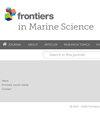不同Zn2+水平对三角褐指藻抗氧化活性、脂肪酸组成及相关基因表达的影响
IF 3
2区 生物学
Q1 MARINE & FRESHWATER BIOLOGY
引用次数: 0
摘要
本研究旨在研究不同浓度的二价锌阳离子(Zn2+)对pennate硅藻(Phaeodactylum tricornutum)生长、抗氧化水平、脂肪酸组成和相关基因表达的影响。锌作为一种普遍存在的环境污染物,通过农业和工业过程进入水生生态系统,对水生生物群产生毒性作用。在梯度Zn2+浓度(0.99 ~ 1000.23 μM)下,用分光光度法测定了三角藻的生长情况。分别通过生化、气相色谱和qRT-PCR分析抗氧化生物标志物、脂肪酸谱和锌响应基因表达。结果表明:适宜的Zn2+浓度对三角角藻的生长至关重要,但高浓度Zn2+ (1000.23 μM)对其生长有明显的抑制作用。锌胁迫还导致活性氧(ROS)的产生,进而引发氧化应激,这可以从抗氧化酶活性和脂质过氧化水平的变化中得到证明。此外,锌胁迫影响了三角藻的脂肪酸组成,特别是高浓度Zn2+处理组。多不饱和脂肪酸(PUFAs)和高不饱和脂肪酸(HUFAs)水平显著降低,而饱和脂肪酸(sfa)和单不饱和脂肪酸(MUFAs)水平升高。基因表达分析表明,锌转运蛋白和抗氧化相关基因的表达发生了变化,表明三角草通过调控基因表达来适应锌胁迫。这些发现为了解微藻对锌污染的生理和分子反应提供了新的认识,为评价锌污染对水生生态系统的潜在影响和制定生物修复策略提供了科学依据。本文章由计算机程序翻译,如有差异,请以英文原文为准。
Effects of different Zn2+ levels on antioxidant activity, fatty acid composition, and related gene expression in Phaeodactylum tricornutum
The present study was undertaken to examine the impact of varying concentrations of divalent zinc cation (Zn2+ ) on the growth, antioxidant levels, fatty acid composition, and related gene expression in a pennate diatom, Phaeodactylum tricornutum . As a prevalent environment contaminant, zinc is introduced into aquatic ecosystems via agricultural and industrial processes, exerting toxic effects on aquatic biota. P. tricornutum was exposed to gradient Zn2+ concentrations (0.99–1000.23 μM), with growth tracked spectrophotometrically. Antioxidant biomarkers, fatty acid profiles, and Zn-responsive gene expression were analyzed via biochemical assays, gas chromatography, and qRT-PCR, respectively. The results showed that appropriate concentrations of Zn2+ were essential for the growth of P. tricornutum , but high concentrations of Zn2+ (1000.23 μM) significantly inhibited its growth. Zinc stress also led to the production of reactive oxygen species (ROS), which in turn triggered oxidative stress, as evidenced by changes in antioxidant enzyme activities and lipid peroxidation levels. Furthermore, zinc stress affected the fatty acid composition of P. tricornutum , particularly in the group exposed to high concentrations of Zn2+ . There was a notable reduction in the levels of polyunsaturated fatty acids (PUFAs) and highly unsaturated fatty acids (HUFAs), while the levels of saturated fatty acids (SFAs) and monounsaturated fatty acids (MUFAs) increased. Gene expression analyses indicated alterations in the expression of zinc transporter proteins and antioxidant-related genes, suggesting that P. tricornutum adapts to zinc stress through the regulation of gene expression. These findings provide new insights into the understanding of the physiological and molecular responses of microalgae to zinc pollution and a scientific basis for evaluating the potential impacts of zinc pollution on aquatic ecosystems and developing bioremediation strategies.
求助全文
通过发布文献求助,成功后即可免费获取论文全文。
去求助
来源期刊

Frontiers in Marine Science
Agricultural and Biological Sciences-Aquatic Science
CiteScore
5.10
自引率
16.20%
发文量
2443
审稿时长
14 weeks
期刊介绍:
Frontiers in Marine Science publishes rigorously peer-reviewed research that advances our understanding of all aspects of the environment, biology, ecosystem functioning and human interactions with the oceans. Field Chief Editor Carlos M. Duarte at King Abdullah University of Science and Technology Thuwal is supported by an outstanding Editorial Board of international researchers. This multidisciplinary open-access journal is at the forefront of disseminating and communicating scientific knowledge and impactful discoveries to researchers, academics, policy makers and the public worldwide.
With the human population predicted to reach 9 billion people by 2050, it is clear that traditional land resources will not suffice to meet the demand for food or energy, required to support high-quality livelihoods. As a result, the oceans are emerging as a source of untapped assets, with new innovative industries, such as aquaculture, marine biotechnology, marine energy and deep-sea mining growing rapidly under a new era characterized by rapid growth of a blue, ocean-based economy. The sustainability of the blue economy is closely dependent on our knowledge about how to mitigate the impacts of the multiple pressures on the ocean ecosystem associated with the increased scale and diversification of industry operations in the ocean and global human pressures on the environment. Therefore, Frontiers in Marine Science particularly welcomes the communication of research outcomes addressing ocean-based solutions for the emerging challenges, including improved forecasting and observational capacities, understanding biodiversity and ecosystem problems, locally and globally, effective management strategies to maintain ocean health, and an improved capacity to sustainably derive resources from the oceans.
 求助内容:
求助内容: 应助结果提醒方式:
应助结果提醒方式:


